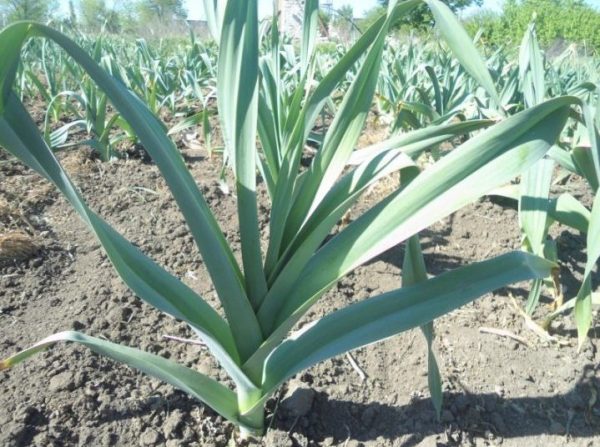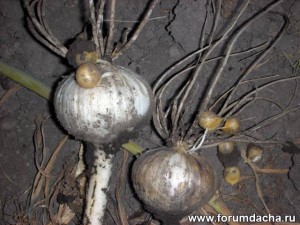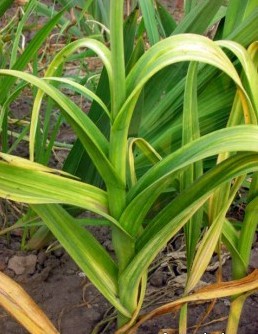What is rockambole?
Rocambole is still not garlic, but onion, albeit a hairstyle one. It differs from garlic in its mild, non-sharp taste, weak, non-pungent odor and the formation of single bulbs - babies. And it is attributed to garlic for its external similarity. It is also similar to leeks, but with a caveat: large rocambole bulbs are divided into cloves. The harmonious taste of the plant has a persistent aroma of both onion and garlic at the same time.

This is what rockambole looks like in the garden
Rocambole is a powerful plant 60-80 cm high, forming 6-9 flat, light green leaves with a faint waxy coating, folded along the central vein. It blooms in a spherical inflorescence of light lilac, bell-shaped, sterile flowers (they do not form seeds).
Planting a rockambole
Choose a place for planting that is illuminated. Crops to which organic fertilizers were applied are considered good predecessors: cucumbers, cabbage, zucchini.
In warm regions, rocambole is planted in the fall. In regions where winters are frosty and even snowless, it makes sense to plant it in early spring - like spring garlic. Before planting, the soil dug up in the fall is deeply loosened, half a bucket of compost or humus is added, as well as a glass of wood ash per square meter. m.
Before planting, divide the bulbs into cloves and soak them overnight in a weak solution of potassium permanganate. The bulbs and cloves are then sorted by size. They are planted in varieties: large, medium, small. As a result, you will get evenly developed and at the same time mature plants.
When planting rocambole, 15-20 cm is maintained between the cloves and bulbs. Rows from rows are placed 25-30 cm apart. Planting depth is 9-10 cm. The larger the cloves, the less often and deeper they are planted. After planting, the bed is mulched with compost or humus 1-2 cm thick. This helps to keep the soil in the bed in a moist, loose state and a crust does not form on the surface.
On good soil, rocambole bulbs grow simply huge - up to 10 cm in diameter and 200-250 g in weight.
At the bottom of the main bulb, up to 15 baby bulbs weighing 1-3 g are formed. The more bulbs there are, the smaller they are. Daughter bulbs, like cloves, are used as planting material.In the first season, from the bulbs and cloves, large single cloves grow, very similar to onions. In the next season, the single cloves are divided into 4-6 cloves and become similar to garlic.
Rocambole care
Caring for rocambole is not complicated and only comes down to regular watering, and weakened plants (with light green leaves) need to be fed. The first feeding is after seedlings with an organic infusion, the second is during the formation of the bulbs with wood ash or phosphorus-potassium fertilizers.
The signal for harvesting is shriveled lower leaves and drooping, yellowed upper leaves. Delay in digging leads to the fact that the bulbs fall apart into cloves, and the baby bulbs are separated from the mother bulb and lost in the ground.
The dug up bulbs are carefully cleaned of soil, tied into loose bunches and, without cutting the tops, hung in a dry, well-ventilated area. When the plants dry out, cut off the roots and stems of the bulbs, leaving small stumps. In a dry basement, the onions are well preserved until spring. This is why spring planting recommendations for rockambole are quite acceptable.
Planting and growing "Egyptian onions", video:



 (2 ratings, average: 4,00 out of 5)
(2 ratings, average: 4,00 out of 5) CUCUMBERS NEVER GET SICK, I'VE BEEN USING ONLY THIS FOR 40 YEARS! I SHARE A SECRET WITH YOU, CUCUMBERS ARE LIKE THE PICTURE!
CUCUMBERS NEVER GET SICK, I'VE BEEN USING ONLY THIS FOR 40 YEARS! I SHARE A SECRET WITH YOU, CUCUMBERS ARE LIKE THE PICTURE! You can dig a bucket of potatoes from each bush. Do you think these are fairy tales? Watch the video
You can dig a bucket of potatoes from each bush. Do you think these are fairy tales? Watch the video
 How our fellow gardeners work in Korea. There is a lot to learn and just fun to watch.
How our fellow gardeners work in Korea. There is a lot to learn and just fun to watch. Eye trainer. The author claims that with daily viewing, vision is restored. They don't charge money for views.
Eye trainer. The author claims that with daily viewing, vision is restored. They don't charge money for views. A 3-ingredient cake recipe in 30 minutes is better than Napoleon. Simple and very tasty.
A 3-ingredient cake recipe in 30 minutes is better than Napoleon. Simple and very tasty. Therapeutic exercises for cervical osteochondrosis. A complete set of exercises.
Therapeutic exercises for cervical osteochondrosis. A complete set of exercises. Which indoor plants match your zodiac sign?
Which indoor plants match your zodiac sign? What about them? Excursion to German dachas.
What about them? Excursion to German dachas.
Planting material is prepared the day before planting. If you come across a multi-toothed onion, you need to clear it of excess husks and divide it into cloves. Overnight, the prepared seeds are soaked in a weak solution of potassium permanganate. The distance between the rows is about 25-30 cm, and in the row - 15-20 cm. The depth of seeding is 9-10 cm. Large cloves can be planted a little less often and deeper than small ones.